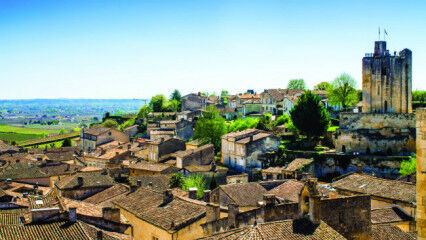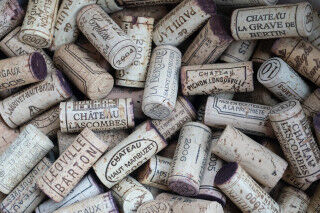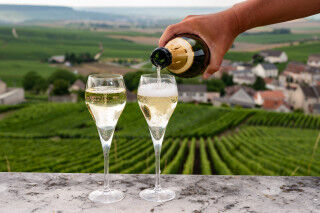Hello again, and welcome back to the world of French Bordeaux wines. So glad you’re persevering with me, and with expert Filippo Bartolotta, author of Di Che Vino Sei (coming soon also in an English version), you’re in very good hands on your exploration of this wine region.
Picking up from my last article on Left and Right Bank wines, we now know how the Left Bank and Right Banks are geographically arranged. What makes their wines different from each other? Which areas and appellations go with which Bank? How confused are you now?!
Within the Left Bank area, the regions are divided further into separate areas (each with different Cru, Châteaux, characteristics, and geography), all following the same principles of viticulture. I'll list them here, just in case you need to do a quick check on any Bordeaux bottles you have in your house and want to check (I did!). The regions are:
- Médoc
- Haut Médoc
- Central Médoc
- Graves
These are further subdivided into more regions (are you getting confused yet?), listed below:
- Bas-Médoc (Médoc region) - no classified growths but home to several Cru Bourgeois.
- Haut-Médoc - Cabernet Sauvignon grapes are the norm here.
- Saint-Estèphe (Haut-Médoc region) - also grows primarily Cabernet Sauvignon, but has the most Merlot grapes of any other Left Bank appellation, heavy clay soil drains slowly during dry summer seasons.
- Pauillac (Haut-Médoc region) - home to three First Growth Crus and 15 other Growth classes, highest elevation of Left Bank estates, and least fragmentation amongst vineyards (vineyards are in the hands of fewer wineries).
- Saint-Julien (Haut-Médoc region) - smallest of all the Médoc sub-regions, proportionally the highest number of Classified Growth Châteaux, with 11 total making up about 80% of all wine production.
- Margaux (Haut-Médoc region) - most southern sub-region in Médoc region, with very favorable climate and soil (lots of gravel for good drainage). Has at least 21 Classified Growth Châteaux, most of any other appellation.
- Southern Médoc (Haut Médoc region) - includes 2 Classified Growth Châteaux.
- Listrac-Médoc (Central-Médoc region) - better value wines since climatic conditions make for less prized wines.
- Moulis-en-Médoc (Central-Médoc region) - Home to several Cru Bourgeois wineries.
- Pessac-Léognan (Graves region) - produces both reds and whites, very interesting soil structure with sediment from multiple geological eras, and interestingly is home to both the only Classified First Growth châteaux outside of Médoc, and all of the Graves 1953 Classified Growths.
- Cérons (Graves region) - sweet white wine, higher yields allowed mean less quality, so wines are overshadowed by the nearby Sauternes and Barsac wines. Mainly use Muscadelle, Sauviugnon Blanc and Sémillon grapes.
- Sauternes (Graves region) - super-famous sweet white wine, created from noble rot (botrytis) allowing for concentration of sugars in grapes still on the vine.
- Barsac (Graves region) - similar to Sauternes wines, also crafted with noble rot. Sand and limestone based soils are a bit flatter than the Sauterne area.
The Right Bank also has appellations/regions, divided as follows:
- Saint-Émilion - producing some of the finest wines in the Right Bank, has its own classification system, and is typically a blend of Merlot, Cabernet Franc, and Cabernet Sauvignon. AOCs include Saint Émilion, Saint-Émilion Grand Cru, Montagne-Saint-Émilion, Saint-Georges-Saint-Émilion, Lussac-Saint-Émilion, Puisseguin-Saint-Émilion.
- Pomerol - mainly Merlot and Cabernet Franc blends, represents the smallest wine region in Bordeaux (3km x 4km), with 150 producers staking claim to vineyard property here. The only Bordeaux region without a classification system (what a relief!).
- Lalande-de-Pomerol - small sub-region just north of Pomerol, comprised of two small villages.
- Fronsac - red wines only, has its own classification system, wines typically a blend of Merlot, Cabernet Franc and Cabernet Sauvignon. Includes sub-region of Canon-Fronsac.
- Castillon - a sub-appellation of Côtes-de-Bordeaux AOC, Merlot and Cabernet Franc grapes.
- Francs - a sub-appellation of Côtes-de-Bordeaux AOC, mainly Merlot-based reds, but 5% of territory is dedicated to Sémillon and Muscadelle grapes for white wines.
- Bourg and Blaye regions - located in upper northern quadrant of the estuary area, produces reds and whites alike (still a Merlot and Cabernet Franc focus) and boasts wine region and production older than that of nearby Médoc. Sub-region and appellations include Blaye, Blaye-Côtes-de-Bordeaux (sub-appellation of Côtes-de-Bordeaux), and Côtes-de-Bourg.
In one final push to understand this immense wine area, there's another region I haven't yet gone over: the southern Entre-Deux-Mers region. Producing a highly regarded but certainly lesser-known crisp white wine, this area also is home to the production of the majority of the Bordeaux AOC or Bordeaux supérieur wine production.
Sub-regions and appellations include:
- Entre-Deux-Mers AOC
- Graves de Vayres AOC
- Premières Côtes de Bordeaux AOC
- Cadillac AOC
- Loupiac AOC
- Sainte-Croix-du-Mont AOC
- Bordeaux-Haut-Benauge AOC
- Entre-Deux-Mers Haut-Benauge AOC
- Côtes-de-Bordeaux-Saint-Macaire AOC
- Sainte-Foy-Bordeaux AOC
Whew - that's a lot of lists and a lot of details to absorb, I know! I'd say that a tasting would be of course helpful, but the top-tier wines are typically a major investment, and one of the reasons why blind tastings are difficult to arrange (unless going through several thousands euros worth of wines are OK to pop). I can state that wines are available that don't have these hefty price-tags attached, and the quality of the Bordeaux wines are all over the map, once you step out from the Classified wines.
With this in mind, as you're navigating future wine purchases, perhaps looking into getting something special for your next big dinner party, this guideline should provide you with some rules to shop by. A starting point in navigating the exciting Bordeaux world is a fun place to start from - happy hunting! Looking for some recipes to match with your wine selections? Mamablip's recipe index is sure to give you that inspiration for a truly stunning food and wine pairing!
Be sure to explore the Mamablip Blog index for loads more details by our stellar wine and food journalists who uncover everything from unusual grape varietals to off-the-beaten-path getaways perfect for the Weekend Warriors looking to escape the city.
Stay tuned and sign up below for the Mamablip Newsletter. Stay up to date on all of Mamablip's kitchen and winery secrets that you won't want to miss!
The Differences Between Right And Left Bank Bordeaux Wine
Left Bank and Right Bank Regional Listings Made Easy
By Nina BernheimApr 07, 2020







